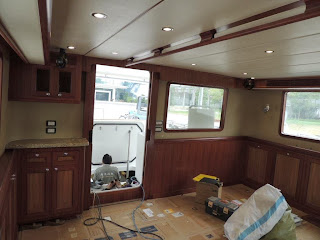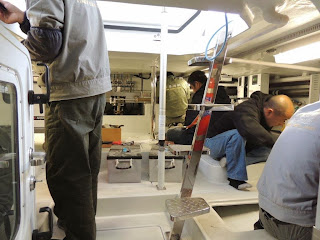One of the last steps the yard performs is tank testing. There are a few systems on Blossom that can't be run until she is sitting in a nice pool of cooling water. When run, these systems suck in some of this water and use it to keep cool. Very much like air passing over the radiator of a car. The systems on Blossom that needed to be run were the wing engine, both generators and the air conditioning. We opted for chilled water air conditioning - the first on a 55/60/63 for some time. Enough time, in fact, that Dometic had to re-engineer the system and then chose to send some engineers out to Xiamen to make sure all worked according to plan.
The good news is that all worked well. There was excessive wear on the main engine's alternator belt, most likely due to the up-sized alternators. This was easily resolved by installing a heavier duty belt. We'll just need to remember to stock the larger belt in our spare parts bin.
One other test was Blossom's trim. How was she going to sit in the water? As it turns out, nice and level. This is with empty tanks, so that may change as the fresh, grey and black tanks fill and empty, but at least we shouldn't need to use fuel for trim ballast. At 5 pounds a gallon, that's not the cheapest material to use. The tender, weighing in at 400 pounds or so, will sit fairly close to centerline so that shouldn't upset things too badly, either.
Lots more pictures after the jump!
Interior wise, she's almost done. A little varnishing here and there, a couple of appliances still needing installation, pocket doors still to go in and a bit of a dusting and she's finished!
The exterior looks good. The swim platform staples are missing but everything else seems to be there.
All the equipment in the machinery spaces has been installed. Of particular note is the wing engine. The mounting problem has been resolved by adding two additional mounts aft and by changing the forward and aft mounts to the harder "red" material. Also note the exhaust. Normally the exhaust would have a water injection sleeve were it exits the engine block and the go up for an anti-syphon loop inside the starboard cabinet in the salon. Since we'd reduced the width of that cabinet to make more space inside the salon, the exhaust stays dry as it extends aft over the engine and rises in a loop into the starboard, aft cabinet in the salon. Water is injected after this loop to cool it down sufficiently to exit through the hull without melting the fiberglass. This will likely add additional heat in the engine room, but does reduce the chance of water passing back through the exhaust and into the engine (a very bad thing).























































No comments:
Post a Comment